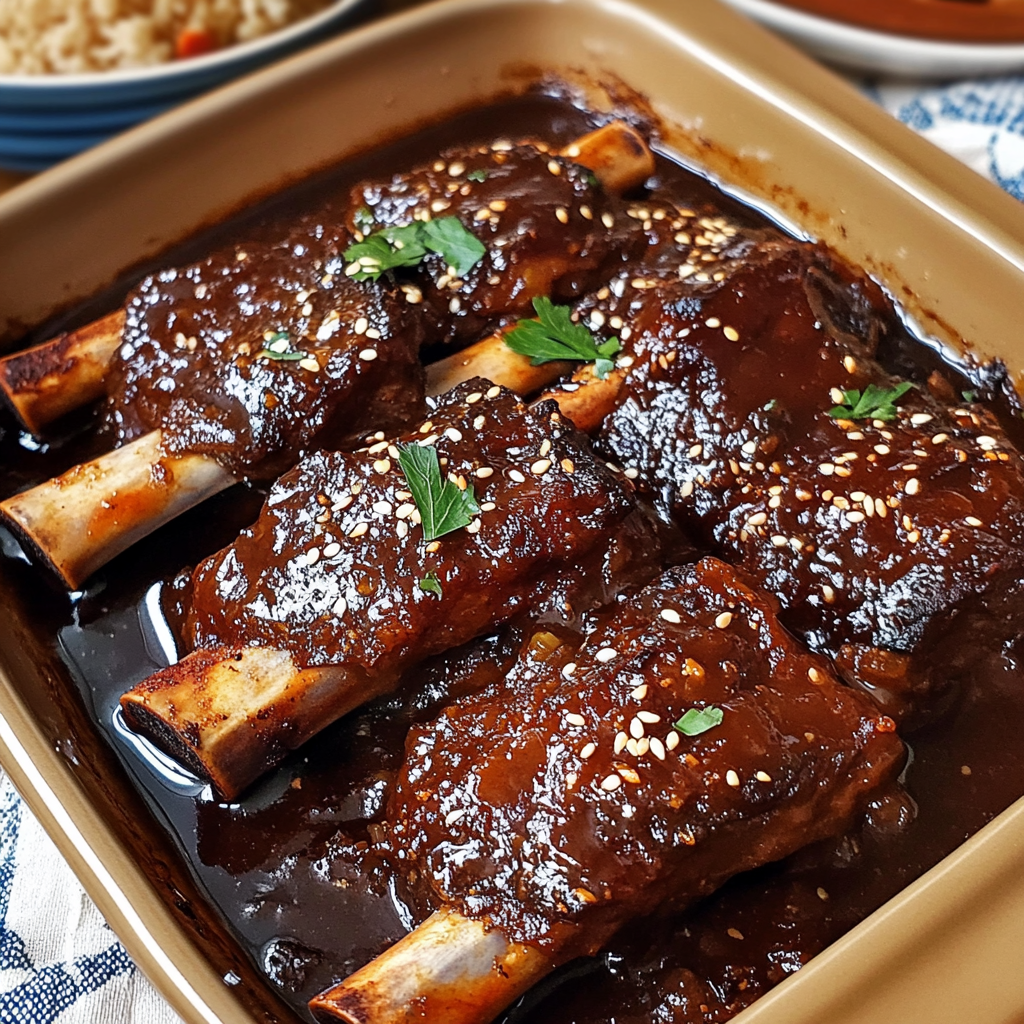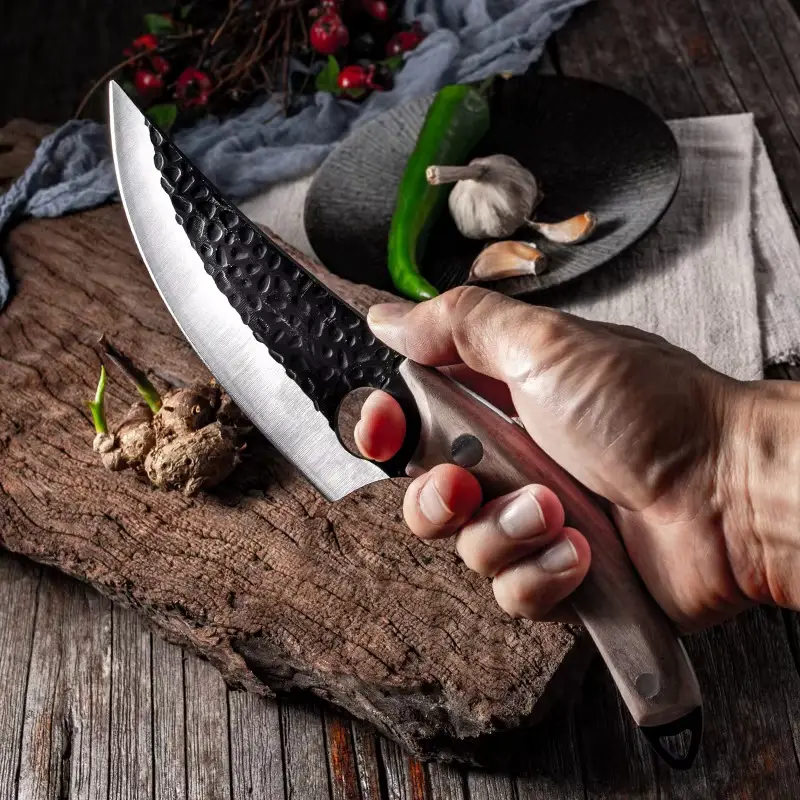Korean Braised Short Ribs, also known as Galbi Jjim (갈비찜), are a quintessential Korean comfort food, beloved for their rich flavors, tender meat, and hearty ingredients. This dish is a feast for the senses, combining fall-off-the-bone beef short ribs with a sweet-savory sauce made from soy sauce, sugar, garlic, and ginger, often enhanced by the addition of vegetables like carrots, radishes, and mushrooms. Slowly braised to perfection, Galbi Jjim is a popular dish served on special occasions, family gatherings, and festive holidays. Whether you’re new to Korean cuisine or a seasoned enthusiast, this recipe will help you create a restaurant-quality dish right in your kitchen.
Why You’ll Love This Recipe
- Melt-in-Your-Mouth Tenderness: The slow braising process ensures the short ribs are incredibly tender and flavorful.
- Deep, Complex Flavors: The combination of soy sauce, garlic, ginger, and sesame oil creates a sauce that’s savory, sweet, and aromatic.
- Comfort Food at Its Best: This hearty dish is perfect for warming up on cold days or celebrating special moments with loved ones.
- Versatile and Adaptable: You can customize this dish with your favorite vegetables or adjust the sweetness and spice levels to your liking.
- Impressive Yet Simple: Though it looks and tastes like a gourmet meal, this recipe is surprisingly easy to follow with basic cooking techniques.
- Great for Entertaining: Korean Braised Short Ribs are sure to impress guests with their stunning presentation and irresistible aroma.
Preparation Time and Servings
- Prep Time: 30 minutes
- Cook Time: 2 hours 30 minutes
- Total Time: 3 hours
- Yield: 6 servings
- Serving Size: 1-2 short ribs with sauce and vegetables
Nutritional Information (per serving)
- Calories: 550
- Carbohydrates: 18g
- Protein: 40g
- Fat: 35g
- Fiber: 3g
- Sugar: 8g
Ingredients
For the Short Ribs:
- 3 pounds bone-in beef short ribs
- 1 large onion, quartered
- 4 cups water
For the Sauce:
- 1/2 cup low-sodium soy sauce
- 1/4 cup brown sugar
- 3 garlic cloves, minced
- 1 tablespoon fresh ginger, grated
- 2 tablespoons mirin (rice wine)
- 2 tablespoons sesame oil
- 1/2 teaspoon black pepper
Vegetables:
- 2 medium carrots, cut into large chunks
- 1 large daikon radish (or Korean radish), peeled and cut into thick slices
- 6 shiitake mushrooms, stems removed
- 1 large potato, peeled and cubed (optional)
- 2 green onions, chopped (for garnish)
- 1 tablespoon sesame seeds (for garnish)
Step-by-Step Instructions
Step 1: Prepare the Short Ribs
Rinse the short ribs under cold water to remove any excess blood and bone fragments. This helps ensure a cleaner, clearer sauce. Soak the ribs in a large bowl of cold water for 30 minutes to draw out impurities.
Step 2: Parboil the Ribs
In a large pot, add the short ribs, quartered onion, and 4 cups of water. Bring to a boil over medium-high heat, then reduce the heat to low and simmer for 10-15 minutes. Skim off any foam or scum that rises to the surface. Drain and rinse the ribs under cold water again. Discard the onion and water, and clean the pot for later use.
Step 3: Make the Sauce
In a medium bowl, combine soy sauce, brown sugar, garlic, ginger, mirin, sesame oil, and black pepper. Mix well until the sugar dissolves.
Step 4: Start Braising
Return the short ribs to the clean pot. Pour the prepared sauce over the ribs and add enough water to just cover the meat (about 2-3 cups). Bring the mixture to a gentle boil, then reduce the heat to low, cover the pot, and simmer for 1.5 hours.
Step 5: Add the Vegetables
After 1.5 hours, add the carrots, radish, shiitake mushrooms, and potato (if using) to the pot. Stir gently to combine, ensuring the vegetables are submerged in the sauce. Cover and continue to simmer for another 45 minutes to 1 hour, or until the meat is fork-tender and the vegetables are cooked through.
Step 6: Reduce the Sauce
If the sauce is too thin, uncover the pot during the last 20 minutes of cooking to let it reduce and thicken. Stir occasionally to prevent sticking.
Step 7: Garnish and Serve
Transfer the braised short ribs and vegetables to a serving platter. Spoon the sauce over the top and garnish with chopped green onions and sesame seeds. Serve hot with steamed white rice or a side of kimchi.
Ingredient Background
- Beef Short Ribs: Bone-in short ribs are the traditional choice for this dish, as the bones add depth and richness to the sauce. Boneless ribs can be used, but the flavor may not be as robust.
- Soy Sauce: The foundation of the sauce, soy sauce provides a savory, umami-packed base that balances perfectly with the sweetness of the sugar.
- Mirin: A sweet rice wine commonly used in Korean and Japanese cooking, mirin enhances the overall flavor and adds a subtle sweetness.
- Daikon Radish: This mild, slightly sweet radish absorbs the sauce beautifully, becoming tender and flavorful during braising.
- Shiitake Mushrooms: Their earthy flavor adds depth to the dish, while their texture contrasts nicely with the tender beef.
- Sesame Oil: Adds a nutty aroma and enhances the dish’s overall flavor.
Technique Tips
- Skim the Sauce: Removing foam and scum during the parboiling process ensures a cleaner-tasting sauce.
- Low and Slow Cooking: Braising the ribs over low heat for a long time is key to achieving tender, flavorful meat.
- Control the Sauce Thickness: Uncover the pot during the last stage of cooking to allow the sauce to reduce to your desired consistency.
- Don’t Skip the Garnishes: The green onions and sesame seeds not only enhance the presentation but also add freshness and a slight crunch.
Alternative Presentation Ideas
- Individual Bowls: Serve each portion in a deep bowl with short ribs, vegetables, and a generous ladle of sauce over rice.
- Family-Style Platter: Arrange the ribs and vegetables on a large platter, with the sauce on the side for drizzling.
- Fusion Tacos: Shred the short rib meat and serve in soft tortillas with a drizzle of the sauce, pickled vegetables, and a sprinkle of sesame seeds.
- Over Noodles: Pair the braised short ribs and sauce with udon or glass noodles for a hearty, satisfying meal.
Additional Tips for Success
- Make Ahead: This dish tastes even better the next day as the flavors deepen. Reheat gently on the stovetop before serving.
- Double the Recipe: Korean Braised Short Ribs freeze well, so consider making a double batch and saving some for a quick, flavorful meal later.
- Balance Sweetness: Adjust the amount of sugar in the sauce to suit your taste preferences. You can also use honey or maple syrup for a natural sweetness.
- Add Spice: For a spicier version, add gochujang (Korean red chili paste) or red pepper flakes to the sauce.
Recipe Variations
- Spicy Galbi Jjim: Stir in 1-2 tablespoons of gochujang or add fresh chili slices for a spicy kick.
- Seafood Twist: Add a handful of peeled shrimp or scallops during the last 15 minutes of cooking for a surf-and-turf variation.
- Vegan Version: Substitute the short ribs with seitan or firm tofu, and use vegetable broth instead of water.
- Instant Pot Galbi Jjim: Use the pressure cooker function to significantly reduce cooking time while still achieving tender results.
Freezing and Storage
- To Store: Transfer cooled leftovers to an airtight container and refrigerate for up to 4 days.
- To Freeze: Place the short ribs and sauce in a freezer-safe container or bag, removing as much air as possible. Freeze for up to 3 months.
- To Reheat: Thaw frozen ribs in the refrigerator overnight, then reheat gently on the stovetop or in the microwave until warmed through.
Healthier Twist Ideas
- Use leaner cuts of beef to reduce fat content.
- Reduce the sugar in the sauce or use a natural sweetener like honey.
- Add more vegetables, such as zucchini, sweet potatoes, or snap peas, to boost the dish’s nutritional value.
- Serve over cauliflower rice instead of white rice for a lower-carb option.
Serving Suggestions for Events
- Holiday Dinners: Serve Galbi Jjim as the centerpiece of a Korean-inspired feast, alongside dishes like japchae, kimchi, and steamed rice.
- Family Gatherings: Pair with a light salad, pickled vegetables, and miso soup for a balanced meal.
- Date Night: Create a romantic dinner with Galbi Jjim, a bottle of red wine, and a dessert like matcha panna cotta or mochi.
- Potluck Party: Bring the short ribs in a slow cooker to keep them warm and flavorful throughout the event.
Special Equipment
- Large Dutch Oven or Heavy-Bottomed Pot: Ideal for evenly braising the ribs.
- Fine-Mesh Skimmer: Helpful for removing foam and scum during parboiling.
- Kitchen Thermometer: To ensure the sauce reduces properly without overcooking.
Frequently Asked Questions
Q: Can I use boneless short ribs?
A: Yes, boneless short ribs can be used, but bone-in ribs add more flavor to the sauce.
Q: Is there a substitute for mirin?
A: You can use rice vinegar with a teaspoon of sugar or omit it altogether for a less sweet sauce.
Q: Can I make this dish spicy?
A: Absolutely! Add gochujang, red pepper flakes, or sliced chili peppers for heat.
Q: What vegetables work best in this dish?
A: Carrots, radish, potatoes, and shiitake mushrooms are traditional, but you can also use zucchini, sweet potatoes, or even chestnuts for variety.
Q: Can I make this dish ahead of time?
A: Yes! The flavors deepen when made a day ahead. Reheat gently on the stovetop before serving.
Q: Can I braise the ribs in a slow cooker?
A: Yes, after parboiling, transfer the ribs and sauce to a slow cooker and cook on low for 6-8 hours or high for 4-5 hours.
Q: What can I serve with Galbi Jjim?
A: Steamed white rice, kimchi, pickled vegetables, and seaweed salad are excellent accompaniments.
Q: How do I thicken the sauce?
A: Let the sauce simmer uncovered during the last 20 minutes of cooking to reduce and thicken naturally.
Conclusion
Korean Braised Short Ribs, or Galbi Jjim, is the epitome of hearty, flavorful comfort food. With its tender, fall-off-the-bone beef and a luscious sauce packed with sweet and savory flavors, this dish is perfect for special occasions or any day you want to indulge in a taste of Korea. Paired with steamed rice and fresh garnishes, Galbi Jjim is a crowd-pleasing meal that’s surprisingly easy to make. Try this recipe today and bring a delicious piece of Korean tradition to your dinner table!



